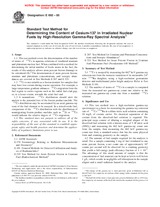Potrebujeme váš súhlas na využitie jednotlivých dát, aby sa vám okrem iného mohli ukazovať informácie týkajúce sa vašich záujmov. Súhlas udelíte kliknutím na tlačidlo „OK“.
ASTM E692-00
Standard Test Method for Determining the Content of Cesium-137 in Irradiated Nuclear Fuels by High-Resolution Gamma-Ray Spectral Analysis
Automaticky preložený názov:
Štandardná skúšobná metóda na stanovenie obsahu cézia 137 v vyhoretého jadrového paliva High - Resolution Gamma - Ray spektrálnej analýzy
NORMA vydaná dňa 10.3.2000
Informácie o norme:
Označenie normy: ASTM E692-00
Poznámka: NEPLATNÁ
Dátum vydania normy: 10.3.2000
Kód tovaru: NS-47681
Počet strán: 3
Približná hmotnosť: 9 g (0.02 libier)
Krajina: Americká technická norma
Kategória: Technické normy ASTM
Anotácia textu normy ASTM E692-00 :
Keywords:
Cesium-137, irradiated uranium and plutonium nuclear fuel, by high-resolution, gamma-ray spectral analysis, test,, Gamma radiation, cesium-137 in irradiated uranium/plutonium nuclear fuels, by, high-resolution gamma-ray spectral analysis, test,, High-resolution gamma-ray spectral analysis, cesium-137 content, of irradiated plutonium and uranium nuclear fuel,, test,, Nuclear fuels (reactor), cesium-137 in irradiated nuclear fuels, by high-resolution gamma-ray, spectral analysis, test,
Doplňujúce informácie
| Significance and Use | ||||||||||
|
This test method uses a high-resolution gamma-ray spectrometer as a basis for measuring the gamma-ray emission rate of 137Cs-137mBa in a dilute nitric acid solution containing 10 mg/L of cesium carrier. No chemical separation of the cesium from the dissolved-fuel solution is required. The principal steps consist of diluting a weighed aliquot of the dissolved-fuel solution with a known mass of 1 M nitric acid (HNO3) and measuring the 662 keV gamma-ray count rate from the sample, then measuring the 662 keV gamma-ray count rate from a standard source that has the same physical form and counting geometry as the sample. The amount of fuel sample required for the analysis is small. For a sample containing 1 mg of fuel irradiated to one atom percent fission, a net count rate of approximately 103 counts per second will be observed for a counting geometry that yields a full-energy peak efficiency fraction of 1 × 10-3. The advantage of this small amount of sample is that the concentration of fuel material can be kept at levels well below 1 g/L, which results in negligible self-absorption in the sample aliquot and a small radiation hazard to the analyst. |
||||||||||
| 1. Scope | ||||||||||
|
1.1 This test method covers the determination of the number of atoms of Cs in aqueous solutions of irradiated uranium and plutonium nuclear fuel. To minimize interference from short-lived fission products, the fuel should decay 4 months or more prior to the gamma-ray emission-rate measurement. 1.2 When combined with a method for determining the initial number of fissile atoms in the fuel, the results of this analysis allows atom percent fission (burnup) to be calculated. The determination of atom percent fission, uranium and plutonium concentrations, and isotopic abundances are covered in Test Methods E267 and E321. 1.3 Cs is not suitable as a fission monitor for samples that may have lost cesium during reactor operation. For example, a large temperature gradient enhances Cs migration from the fuel region to cooler regions such as the radial fuel-clad gap, or to a lesser extent, towards the axial fuel end. 1.4 The Cs distribution may be ascertained by an axial gamma-ray scan of the fuel element to be assayed. In a mixed-oxide fuel, comparison of the Cs distribution with the distribution of nonmigrating fission-product nuclides such as Zr or Ce would indicate the relative degree of Cs migration. A nonuniform Cs distribution should alert the analyst to the potential loss of the fission nuclide. 1.5 This standard may involve hazardous materials, operations, and equipment. This standard does not purport to address all of the safety problems associated with its use. It is the responsibility of whoever uses this standard to consult and establish appropriate safety and health practices and determine the applicability of regulatory limitations prior to use. |
||||||||||
| 2. Referenced Documents | ||||||||||
|




 Cookies
Cookies
